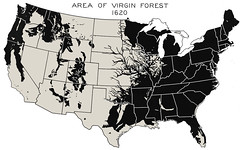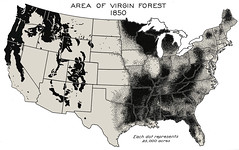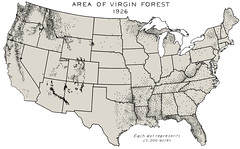Historic Loss of Primary (Virgin) Forests
Although definitions vary, a primary (or “virgin”) forest often means a forest of native species where there are no clearly visible indications of human disturbance and where ecological processes are not significantly disturbed. Identifying primary forests with precision is difficult, since Native Americans used fire to manage forests prior to European settlement. Given this limitation, one way to approach a definition of virgin forests in the South is those that have not been cleared since European settlement.
At the time of European settlement in North America, such forests covered nearly all of the East Coast. During the next two centuries, agriculture was the most important driver of forest loss in the South. By 1850, large portions of original forest had been cleared for agriculture, although substantial areas remained. Lands along the Atlantic coastal plain, which were the most densely populated areas of the South, saw the greatest loss of forests over this period. However, western areas of the region were largely unsettled, and land in Florida and the Appalachians was difficult to access, clear, and farm.
After the Civil War ended in 1865, the era of industrial logging began in earnest in the South. New railroads moved workers and heavy equipment and transported cut logs to mills and markets, making logging newly profitable throughout the region. The railroads themselves required vast quantities of lumber for crossties. Between 1870 and 1920, the South lost tens of millions of acres of forest.
By the end of the twentieth century, virtually no substantial tracts of virgin forest remained in the South. Remnants can be found in protected lands in parts of the Great Smoky Mountains and in southwestern Florida, but nearly all the South’s current extensive forested area has been previously logged. The remaining forests are located in areas that were difficult to access due to steep or swampy terrain.
Trani, Margaret K. 2002b. “Terrestrial Ecosystems.” In Wear, David N., and John G. Greis, eds. Southern Forest Resource Assessment. Gen. Tech. Rep. SRS-53. Asheville, NC: U.S. Department of Agriculture, Forest Service, Southern Research Station.





